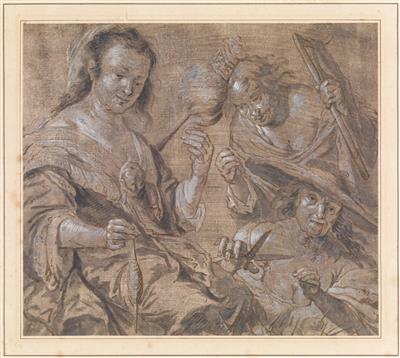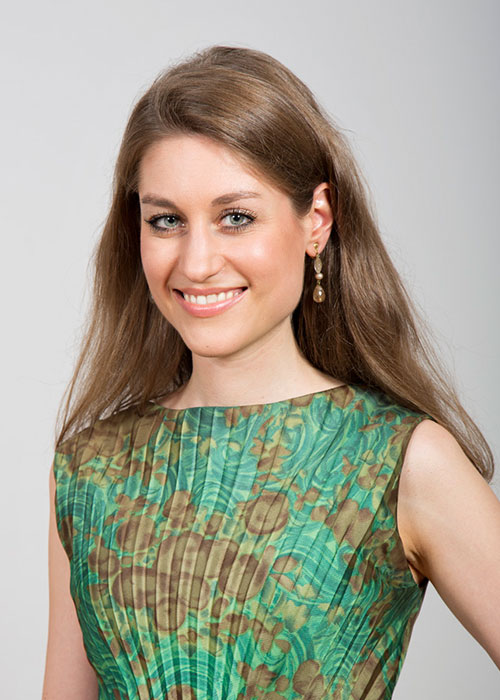Studio of Bernardo Strozzi

(1581-1644), Le tre Parche (The Three Fates), pen and brown ink, brown and grey wash, white heightenings, on prepared paper, 20,5 x 23,3 cm, laid down on support, mounted, unframed, (Sch)
Provenance:
European private collection.
Comparable literature: Luisa Mortari, Bernardo Strozzi, Rome 1995, Cat. 453, 455, 456, 67 v., Fig. pp. 50, 181-182, 225.
The present sheet is presumably a preliminary drawing or a „ricordo“ for the painting „The threee Fates“ in the Bononmi collection in Milan (compare Mortari 1995, Cat. 453, Fig. p. 50, 181-82; oil onn canvas, 144 x 130 cm). The drawing shows the three goddesses of fate: Clotho, spinning the thread of human life, the second Lachesis was the apportioner and weaver of the thread and the third, Atropos, the inevitable who cut the thread and ended human life. They are represented with their attributes spindle, rod and abhorred shears. Apart from the painting in Milan Mortari (1995) mentions two other versions in London (Heim collection, oil on canvas, 140 x 167 cm, Cat. 455) und Milan (private collection, oil on canvas, 130 x 144 cm, Cat. 456). Mortari dated the paintings to c. 1635 and the first years of Strozzi’s Venetian period because of the coarse and naturalistic way of rendition of the figures and because of the dark colors. Apparently Strozzi occupied himself several times with the subject. It seems therefore likely that he did not only execute detail studies but also made recordings of paintings to which he could later turn to in order to develop other versions of the subject. The present drawing could be such a recording. White heightenings indicate how the arist conceived light in the painting, dark areas and shades were rendered with grey washes. Only one detail study with the head of Atropos is known today (Mortari 1995, Cat. 67 v.) and is preserved in the Museum Boymans-van Beuningen in Rotterdam. This drawing is brought in connection with other works (“Head of an old woman” of 1635-40, black and white chalk) in the Hermitage of Saint Petersburg and “Saint Sebastien healed by nuns” in the church S. Benedetto in Venice. The same face reappears in the present design and its following painting “The Three Fates”. Style and the unusual technique of the drawing on prepared paper are also comparable with a study for “The miracle of Saint Zita” (Mortari 1995, Cat. 7, p. 225) in Florence, Gabinetto dei Disegni e Stampe, Inv. 2151 F.
Specialist: Mag. Astrid-Christina Schierz
 Mag. Astrid-Christina Schierz
Mag. Astrid-Christina Schierz
+43-1-515 60-546
astrid.schierz@dorotheum.at
28.04.2014 - 17:00
- Estimate:
-
EUR 3,000.- to EUR 4,000.-
Studio of Bernardo Strozzi
(1581-1644), Le tre Parche (The Three Fates), pen and brown ink, brown and grey wash, white heightenings, on prepared paper, 20,5 x 23,3 cm, laid down on support, mounted, unframed, (Sch)
Provenance:
European private collection.
Comparable literature: Luisa Mortari, Bernardo Strozzi, Rome 1995, Cat. 453, 455, 456, 67 v., Fig. pp. 50, 181-182, 225.
The present sheet is presumably a preliminary drawing or a „ricordo“ for the painting „The threee Fates“ in the Bononmi collection in Milan (compare Mortari 1995, Cat. 453, Fig. p. 50, 181-82; oil onn canvas, 144 x 130 cm). The drawing shows the three goddesses of fate: Clotho, spinning the thread of human life, the second Lachesis was the apportioner and weaver of the thread and the third, Atropos, the inevitable who cut the thread and ended human life. They are represented with their attributes spindle, rod and abhorred shears. Apart from the painting in Milan Mortari (1995) mentions two other versions in London (Heim collection, oil on canvas, 140 x 167 cm, Cat. 455) und Milan (private collection, oil on canvas, 130 x 144 cm, Cat. 456). Mortari dated the paintings to c. 1635 and the first years of Strozzi’s Venetian period because of the coarse and naturalistic way of rendition of the figures and because of the dark colors. Apparently Strozzi occupied himself several times with the subject. It seems therefore likely that he did not only execute detail studies but also made recordings of paintings to which he could later turn to in order to develop other versions of the subject. The present drawing could be such a recording. White heightenings indicate how the arist conceived light in the painting, dark areas and shades were rendered with grey washes. Only one detail study with the head of Atropos is known today (Mortari 1995, Cat. 67 v.) and is preserved in the Museum Boymans-van Beuningen in Rotterdam. This drawing is brought in connection with other works (“Head of an old woman” of 1635-40, black and white chalk) in the Hermitage of Saint Petersburg and “Saint Sebastien healed by nuns” in the church S. Benedetto in Venice. The same face reappears in the present design and its following painting “The Three Fates”. Style and the unusual technique of the drawing on prepared paper are also comparable with a study for “The miracle of Saint Zita” (Mortari 1995, Cat. 7, p. 225) in Florence, Gabinetto dei Disegni e Stampe, Inv. 2151 F.
Specialist: Mag. Astrid-Christina Schierz
 Mag. Astrid-Christina Schierz
Mag. Astrid-Christina Schierz
+43-1-515 60-546
astrid.schierz@dorotheum.at
|
Buyers hotline
Mon.-Fri.: 10.00am - 5.00pm
kundendienst@dorotheum.at +43 1 515 60 200 |
| Auction: | Master Drawings, Prints before 1900, Watercolours, Miniatures |
| Auction type: | Saleroom auction |
| Date: | 28.04.2014 - 17:00 |
| Location: | Vienna | Palais Dorotheum |
| Exhibition: | 18.04. - 28.04.2014 |
